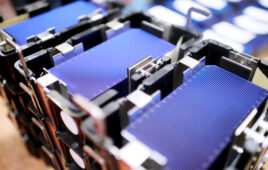From the smallest micro- and string inverters to the largest centrals, one thing was clear as I walked the show floor at Solar Power International: In this year’s new inverter launches, simplicity was paramount.
Here’s a roundup of the new power electronics I checked out.
1. SMA America’s Sunny Central UP with Virtual Support
SMA aims to solve the issue of O&M complexity for central inverters with its new Virtual Support app that comes with its new Sunny Central UP inverter for large-scale solar projects. The augmented reality app allows customers to scan a code and then see exactly which parts of the product need servicing.
The inverter itself has all parts integrated including switchgear and transformer and comes in one piece on a platform that can be shipped anywhere easily. An SMA DC converter can be added separately to include plug-and-play energy storage.
.@SMA_America showed me the company’s new Virtual Reality app to help contractors see exactly what needs serviced in its central inverters. Super cool! pic.twitter.com/OrfXzT4s41
— Kelsey Misbrener (@SolarKelseyM) September 25, 2019
2. Sungrow’s utility-scale string inverter
Sungrow has launched its first string inverter that competes with its central: The SG250HX. This compact, 1,500-V inverter is battery storage-ready with DC connections. Field service manager Patrick Betzel said the standout point of this 250-kW inverter is its small footprint for the same amount of power.
In the interest of simplicity, this inverter ships as a full solution for 3-MW and 4.5-MW projects, including a medium voltage transformer and all other components.
3. Fronius’s first hybrid inverter
Fronius enters the hybrid inverter market in the United States with its Primo Gen 24 Plus. It’s compatible with DC or AC coupling and features the same easy snap-in installation as the company’s popular Symo inverter. The product is even packaged for the simplest installation possible, with the mounting bracket on top and the ability to commission it via an app. This inverter also uniquely features the heatsink in the front of the inverter instead of the bottom.
4. APsystems’ rapid shutdown solution
Even though its microinverters are inherently rapid shutdown devices, APsystems has entered the rapid shutdown game with its own RSD called APsmart. This SunSpec-certified device can be attached to modules three different ways (pictured). The device comes with its own transmitter but also works with any SunSpec-certified transmitting device.
5. Ginlong Solis’s next generation of three-phase inverters
Ginlong’s new 125-kW string inverter for C&I and utility applications boasts a conversion efficiency of 99.1%. This 1,500-V inverter has integrated AC and DC disconnect switches. Along with new products, Ginlong aims to be a leader in service with its new mobile portal. Customers can access a host of FAQs, watch instructional videos or chat with service technicians on the app as well as submit service tickets online.
6. Power Electronics’ mega-inverter for utility-scale solar-plus-storage
Power Electronics brought quite the prop to Solar Power International — its new 40,000-pound HEM HYBRID inverter. This behemoth of an inverter can be directly connected to energy storage containers thanks to its integrated DC-DC converters. These inverters come with everything contractors need to connect directly to the grid — you just need a crane to install it.
7. SolarEdge’s storage inverter for whole-home backup
SolarEdge’s founder Lior Handelsman said the evolving role of inverters is to become the energy managers of the home, and the company’s new products illustrate that vision. The new Single Phase StorEdge inverter can be paired with the company’s Single Phase StorEdge Battery, Smart Energy Hot Water device, Smart Energy Switch/Relay and other devices to make the home as smart and energy efficient as possible.
8. Delta’s C&I inverter with industry-high power density
Delta’s M80U inverter for the C&I space has the highest power density available currently in string inverters with 80 kW in 180 pounds. The company received high marks in PV Evolution Labs‘ first PV Inverter Scorecard in 2019 and prides itself on keeping inverters simple. It does not include screens on its inverters since that’s an error-prone feature that can easily be avoided by using its app for all inverter information instead.
9. Alencon’s DC-DC optimizer for re-powering solar projects
Alencon Systems’ new DC-DC optimizer is cheaper and works faster than previous versions. This iteration of the SPOT produces higher power at the same price point. It can be used for re-powering older, lower-voltage PV projects, adding DC-coupled storage to a solar project or building microgrids.
10. Yaskawa Solectria’s simplified commercial inverter
Yaskawa Solectria’s PVI 25TL inverter is one of the smallest three-phase commercial inverters on the market and comes with integrated module-level rapid shutdown. Contractors can perform remote diagnostics and firmware upgrades to this inverter to cut down on truck rolls. This product also features a simplified combiner box to be as installer-friendly as possible.














I don’t like this new trend of eliminating the inverter LED screen and forcing installers to use an app. Its torture. The LED screens were simple and error free.
You are missing Sol-Ark’s new 12KW Hybrid Inverter! Best of class!
Great write-up Kelsey!!